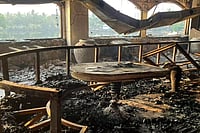The Government of Tamil Nadu has improved the facilities for tourists at the temples at the Mamallapuram Shore Temple.
Mamallapuram is a popular tourist destination in Tamil Nadu and is known for its temples and historic monuments.
As part of the improved facilities, a solar power plant, water treatment plant, new benches, and electric buggies have been put in place.
Sharing the development on Twitter, the Department of Information and Public Relations (DIPR) said, "Mamallapuram shore temple gets more amenities for tourists."
The Hindu reported that the facilities have been installed under a partnership between Renault Nissan Technology and Business Centre (RNTBC) and Hand in Hand (HIH) India. It has been dubbed a Green Heritage Project.
As part of the corporate social responsibility (CSR) project, three 10 KW solar power plants, kiosks with RO water, 25 stone benches, and a parking lot with three e-buggies have been installed, reported The Hindu.
Debashish Neogi, Managing Director of RNTBC, was quoted as saying that it was India's first green heritage monument, symbolising the fusion of a heritage site preservation and sustainability.
With such facilities, the Mamallapuram Shore Temple have become the first UNESCO heritage site to get such facilities, according to the DIPR.
The Mamallapuram Shore Temple is a complex of historic Hindu temples in Mamallapuram, Tamil Nadu. The shrines in the complex are considered to be the finest example of early South Indian temple architecture. There are two shrines made dedicated to Hindu Gods Vishnu and Shiva. Both of them are made of cut stones instead of being cut out of caves like other temples in the region.
"Its style is characterized by a pyramidal kutina-type tower that consists of stepped stories topped by a cupola and finial, a form quite different from the northern Indian sikhara," says The Britannica Encyclopaedia.



















_.jpg?w=200&auto=format%2Ccompress&fit=max)






